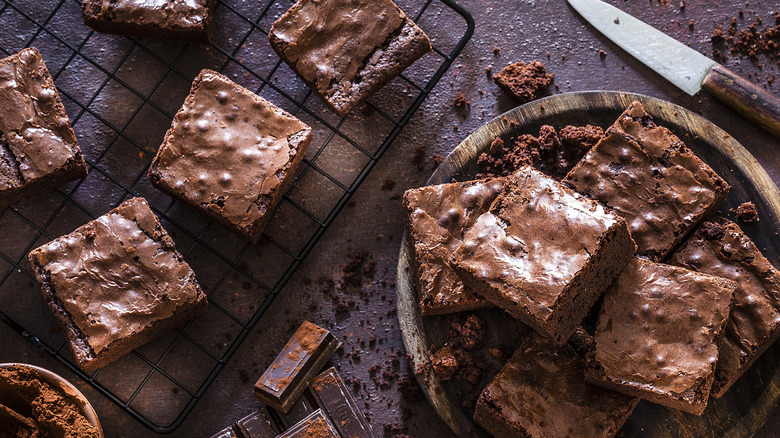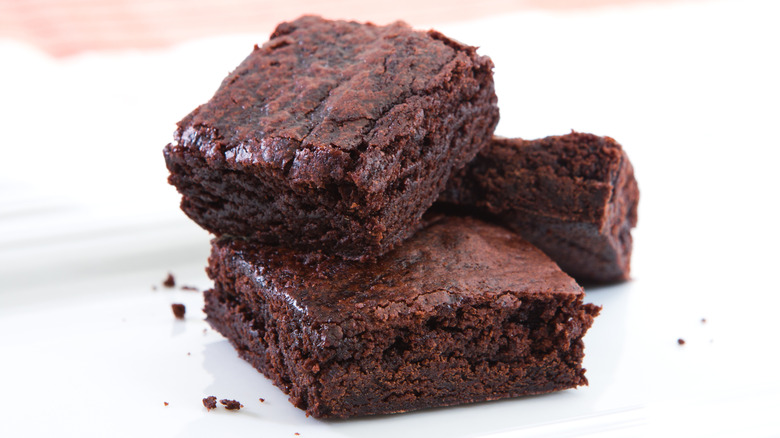Alton Brown's Bake And Pause Technique For Unbeatable Brownies
How do you like your brownies? If soft and tender with a nearly gooey center sounds like your ideal brownie, then Alton Brown's recipe is what you're looking for.
The distinct appeal of a brownie lies in its unctuous inner texture, but those new to baking might feel mystified about how to achieve it. If you're looking for credible culinary guidance, rest assured that Brown, the renowned kitchen hack maestro, has your back. And here's an exciting revelation: he also has a real penchant for brownies. In fact, Brown has recently revamped his brownie recipe just to improve upon something that was already delicious.
For his "cocoa brownies: reloaded" recipe, Brown suggests a specific cooking technique that guarantees a center that is even more ooey. Rather than baking the brownies at 325 degrees Fahrenheit for 25-30 minutes, Brown proposes a lower temperature and a brief pause during the process. His suggestion involves baking them at 300 degrees Fahrenheit for 15 minutes, then removing them to cool and rest for the same amount of time — this part is especially important. He then resumes the baking process until the brownies reach a temperature of about 195 degrees Fahrenheit. The result? Brownies with an impeccable texture both inside and out. Let's delve into why this approach works so marvelously.
Does the pause really work?
It might seem like an extra step, but baking brownies at a lower oven temperature and giving them time to rest really helps with their texture. By keeping the oven temperature low during the initial baking phase, you prevent the delicate exterior of the brownies from crisping up too quickly or becoming burnt, while the inside remains undercooked. The low and slow baking method also helps the brownies retain moisture and prevents them from drying out as rapidly as they would at higher temperatures.
Allowing the brownies to cool and rest outside of the oven before completing the baking process enables the interior to congeal and set slightly within the brownies. This gives them that oeey texture inside we all crave.
According to Brown's recipe, after the resting period, you continue baking the brownies until they reach a core temperature of 195 degrees Fahrenheit, ensuring that the eggs and flour in the recipe are safe to consume. The exciting part is that you can truly use this technique with any brownie recipe, provided you bake them for a sufficient duration to reach a safe temperature after the resting and cooling period.
Why not use a different technique?
While many might be tempted to skip the resting step and simply underbake the brownies in an attempt to get the desired texture, you really don't want to consume ingredients that are raw. Foodborne illnesses are no fun, regardless of how tasty something might be when you eat it.
If you're wondering why you can't just continuously bake the brownies at 300 degrees Fahrenheit until they reach a safe temperature, the truth is that you technically can, but you won't get the same internal texture. That 15-minute cooling and resting period allows the center of the brownies to settle, becoming more dense and compact before returning the pan to the hot oven.
When you're baking, you're effectively experiencing chemistry in real time. Your leavening agents will cause the batter to rise and fluff up as it's baked. Without a rest period, the batter will stay fluffy until the brownies are baked through, resulting in a more airy texture. However, by allowing the batter to settle back down again before finishing cooking, you're disrupting that rising process and creating a more densely-compacted center that will remain gooey even when cooked through. Textural preferences are subjective, however, so if you want to experiment by baking brownies two ways, we doubt anyone in your household will complain.



